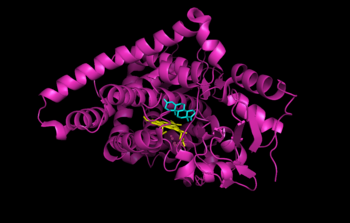Aromatase: Difference between revisions
Jump to navigation
Jump to search


imported>David E. Volk No edit summary |
imported>David E. Volk No edit summary |
||
| Line 1: | Line 1: | ||
{{subpages}} | {{subpages}} | ||
{{Image|Aromatase CytP450 with androstenedione.png|right| | {{Image|Aromatase CytP450 with androstenedione.png|right|350px|Human placental aromatase bound to ligands [[androstenedione]] (cyan) and [[heme]] (yellow). Coordinates obtained from the RCSB Protein Data Bank (3EQM).<ref>[http://www.rcsb.org/pdb/explore.do?structureId=3EQM 3EQM]</ref>}} | ||
'''Aromatase''' is an [[enzyme]] that removes the C-19 methyl group and oxidizes the 3- and 17-positions of steroids, including reactions that convert androgenic steroids (testosterone) into estrogenic steroids (estrogen). Because some tumors are estrogen-sensitive, [[aromatase inhibitor]]s are sometimes used to treat cancer, mostly in post-menopausal women because aromatase inhibitors do not block estrogen synthesis in the ovaries. | '''Aromatase''' is an [[enzyme]] that removes the C-19 methyl group and oxidizes the 3- and 17-positions of steroids, including reactions that convert androgenic steroids (testosterone) into estrogenic steroids (estrogen). Because some tumors are estrogen-sensitive, [[aromatase inhibitor]]s are sometimes used to treat cancer, mostly in post-menopausal women because aromatase inhibitors do not block estrogen synthesis in the ovaries. | ||
== References == | |||
</references> | |||
Revision as of 15:26, 31 May 2009

(CC) Image: David E. Volk
Human placental aromatase bound to ligands androstenedione (cyan) and heme (yellow). Coordinates obtained from the RCSB Protein Data Bank (3EQM).[1]
Human placental aromatase bound to ligands androstenedione (cyan) and heme (yellow). Coordinates obtained from the RCSB Protein Data Bank (3EQM).[1]
Aromatase is an enzyme that removes the C-19 methyl group and oxidizes the 3- and 17-positions of steroids, including reactions that convert androgenic steroids (testosterone) into estrogenic steroids (estrogen). Because some tumors are estrogen-sensitive, aromatase inhibitors are sometimes used to treat cancer, mostly in post-menopausal women because aromatase inhibitors do not block estrogen synthesis in the ovaries.
References
</references>